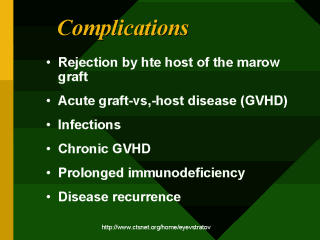| front |1 |2 |3 |4 |5 |6 |7 |8 |9 |10 |11 |review |
 |
Complications: Early complications include rejection by the host of the marrow
graft, acute GVHD, and infections. Later complications include chronic GVHD, prolonged
immunodeficiency, and disease recurrence. Graft-vs.-host disease: GVHD is a disease in which immunologically competent donor T cells react against antigens in an immunologically depressed recipient. A major problem in allogeneic transplantation is the prevention and control of GVHD. Symptoms and signs of acute GVHD are fever; exfoliative dermatitis; hepatitis with hyperbilirubinemia; vomiting; diarrhea and abdominal pain, which may progress to an ileus; and weight loss. Although increased knowledge of the major histocompatibility complex has aided understanding of the etiology of GVHD, patients who are matched at the A, B, C, and DR loci still have a 30 to 60% incidence of GVHD. Surprisingly, a GVHD syndrome has even been reported in patients receiving syngeneic transplants (between identical twins) or autologous transplants (with their own marrow). Although the introduction of cyclosporine in the early 1980s has greatly reduced both the incidence and severity of GVHD, it continues to be the major cause of mortality and severe morbidity after allogeneic BMT.About 1/3 to 1/2 of BMT recipients develop a more indolent chronic form of GVHD. Although the skin, liver, and gut remain the organs primarily affected, other areas of involvement (eg, joint, lung) are also noted. Interestingly, bronchiolitis obliterans similar to that seen after lung transplantation can occur. Ultimately, 20 to 40% of the patients die of complications associated with GVHD, the incidence being higher when donor marrow is not from an HLA-identical sibling. In patients without chronic sequelae of GVHD, all immunosuppression can be stopped 6 mo after BMT, making late complications rare in these patients, in contrast with the continued need for immunosuppressants and resulting complications in solid organ transplant recipients. One area of active clinical research aimed at reducing the incidence of GVHD has been the removal of T cells from the donor marrow with monoclonal antibodies, using the rosetting technique, or mechanical separation before reinfusion of the marrow. T-cell depletion has been very effective in decreasing both the incidence and severity of GVHD; however, the incidences of engraftment failure and relapse are increased. A possible explanation is that the cytokines generated in the graft-vs.-host reaction promote stem cell multiplication and maturation necessary for engraftment. Patients who develop GVHD have significantly lower relapse rates, suggesting that T cells responsible for GVHD are probably involved in a graft-vs.-leukemia effect. Other agents used to prevent or treat GVHD include methotrexate, corticosteroids, ATG, and monoclonal antibodies against antigens expressed on mature T cells. GVHD may also follow blood transfusions in exceptional cases, since even small numbers of donor T cells can induce this reaction. Such situations include intrauterine fetal blood transfusions and transfusions in immunodepressed patients (eg, BMT recipients, leukemia, lymphoma, neuroblastoma, Hodgkin's and non-Hodgkin's lymphoma). Blood products to be given to patients at risk should be irradiated to prevent development of GVHD (see in Ch. 129). Infection: Following the preparative regimen for BMT, the WBC count can take 2 to 3 wk to recover. During this time, patients are very susceptible to infections. Acyclovir prophylaxis has dramatically decreased the risk of herpes simplex infections during this time. Even after engraftment, patients continue to be immunocompromised and at risk for infections because of the drugs used to treat GVHD. A worrisome late infection is cytomegalovirus interstitial pneumonitis, which generally occurs 40 to 60 days after transplantation. Patients present with tachypnea, dyspnea, hypoxemia, and a chest x-ray with bilateral pulmonary infiltrates. The mortality rate of cytomegalovirus interstitial pneumonitis was 80 to 90%, but treatment with ganciclovir and passive immunity with immunoglobulin has decreased the mortality rate to about 25 to 40%. Patients are also at risk of developing pneumocystis pneumonia, but prophylactic use of trimethoprim-sulfamethoxazole has dramatically decreased the incidence of this infection. |
| front |1 |2 |3 |4 |5 |6 |7 |8 |9 |10 |11 |review |